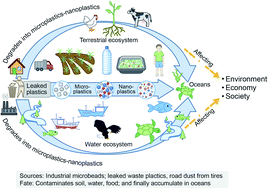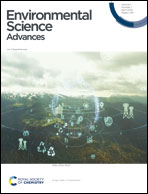Microplastics in ecosystems: their implications and mitigation pathways†
Abstract
Microplastic (MP) pollution is an emerging threat to terrestrial and aquatic ecosystems. It is abundant, environmentally persistent, and complex. Environmental, economic, and societal concerns over the effect of MP pollution in ecosystems have attracted enormous attention for research on alternatives and potential remediation options. Plastic/MP pollution in aquatic ecosystems has been extensively studied and summarized; however, studies on terrestrial ecosystems are limited. Neither recent technological advances in the remediation of MP pollution nor their economic and societal implications have been thoroughly examined. This study compiled information on MP pollution in ecosystems and food chains, emphasizing the terrestrial ecosystem, recent technological advances, economic and societal implications, and the remediation of microplastic pollution. The perspectives of future activities have also been discussed and a potential remediation pathway has been outlined. MPs are pervasive in all channels (soil, water and atmosphere) of human interactions and hazardous to biota in ecosystems, eventually contaminating food systems and affecting human health. Leaked plastics, plastic-containing products (biosolids, wastewater, fertilizers, and pesticides), and plastic mulch used in agriculture, polyamide fabrics, and cosmetics products are the major sources of MP pollution. The development of alternatives to conventional plastics and materials that can abate or minimize the problems associated with MPs and the improvement in waste management systems to stop plastic waste leakage into ecosystems as well as cleanup drives are critical to eradicating MPs. Biodegradable plastic is recognized as an alternative to conventional plastic as it degrades faster than conventional plastics and is more prone to microorganisms. Biodegradable plastics coupled with bioremediation (eradicating MPs by using microorganisms) of MPs show a potential means to eradicate problems associated with MPs polluting ecosystems. Consequently, biodegradable plastics that are produced from non-edible biomass such as algae can be a potential pathway to eradicate MP pollution for sustainable ecosystems. Therefore, comprehensive studies are essential to assess the environmental, economic and social impacts of biodegradable plastics and bioremediation of MPs in ecosystems to avoid any potential risk to ecosystems and health.

- This article is part of the themed collections: Environmental Science Advances Recent Review Articles, Topic Collection: Microplastics, World Earth Day, Best Papers of 2022 from RSC’s Environmental Science journals and SDG14: Life Below Water – Marine Litter (Plastics and Pollution)


 Please wait while we load your content...
Please wait while we load your content...